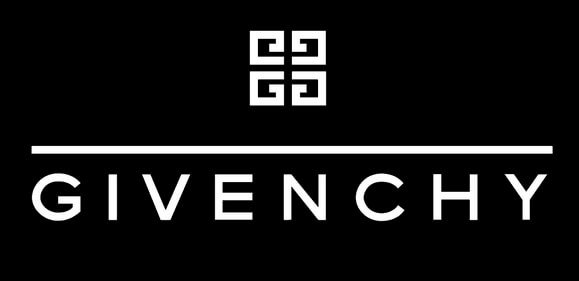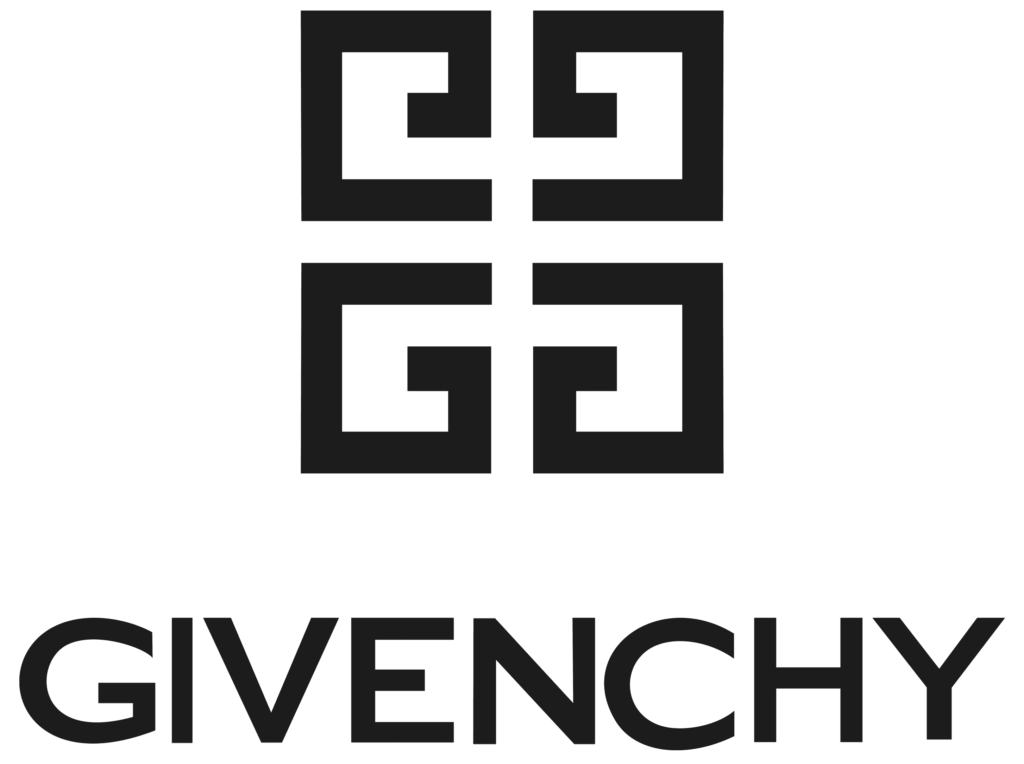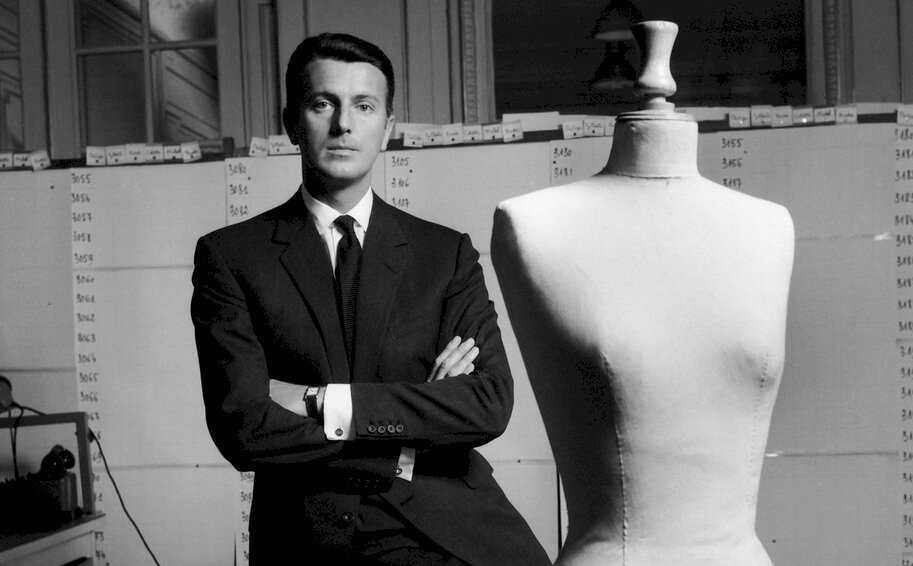Let’s get an insight into the Givenchy logo and some history behind the French fashion brand.
The Givenchy logo is one of the celebrated trademarks in the fashion industry. Also, it leads one of the most successful French fashion brands in the world. It debuted the same year the brand started. However, the current one is refined, giving it a modern look.
Pierre Dinand is credited for creating the first Givenchy emblem. However, Paul Barnes designed the latest edition in 2003, updating the original one. Though simple, the logo is artistically appealing. It comprises a wordmark and a graphic crafted out of quadruple—Gs.
Often, the wordmark comes below the icon, evoking the logo’s complete charisma. However, the company sometimes uses them separately without losing its personality. The logo has been a powerful ambassador, elevating the humble brand to a global prominence.
Givenchy is well-known for its haute couture clothing, perfumes, cosmetics, and accessories. Also, besides its iconic ambassador, Audrey Hepburn, the brand has worked with several other celebrities. You can recall Farah Pahlavi, Gloria Guinness, and Beyoncé Knowles.
The minimalist attitude of the logo makes it versatile. So, the company uses it on any advertising medium. So it’s common to find it on bags, shirts, skirts, banners, websites, etc. Today, the brand is owned by LVMH, and its creative director is Matthew Williams.
Givenchy Logo Evolution And Its History

The Givenchy trademark is about 70 years old. Yet, it has changed little. The minor update happened in 2003, fine-tuning its identity. Now, a logo that stays that long with a minor change shows it’s effective. Therefore, it would be unfair to change a winning logo. What do you think?
1952 – Present:
Givenchy has a simple yet eye-catching emblem. It comprises two parts—a graphic and a wordmark. Referencing the founder’s name, the wordmark is a sans-serif type executed in caps. Also, the letters are spaced to make it more legible, making it even more appealing. Sometimes, the wordmark is escorted by the word—Paris, paying tribute to the country’s capital city.
Now the graphic part is creative. It comprises a quadruple—G, creating a special square. The designer coined it from the founder’s initial letter G. Also, he rotated the letters differently, reminding us of the Celtic ornament. Here, you’ll find two marks above and two below, mirroring each other. Often, the graphic and wordmark are used together or separately.
More so, the brand uses a different logo for its perfume products. The designer ushered in this visual identity since the wordmark—Givenchy couldn’t fit the frame size. So instead, it comprises the iconic G—graphic mark and the wordmark—Parfums.
Why Does Givenchy Logo work?

1. The Logo Is Simple:
Givenchy has one of the modest logos in the fashion industry. To evoke its personality, the designer avoided too many graphic details. Therefore, you’ll spot a wordmark and a special symbol. Because of this simplicity, the emblem is highly recognizable. Again, its minimalist personality makes it easy for customers to understand.
2. The Logo Is Memorable:
The world’s iconic trademarks share some vital qualities. And memorability is one such example. Luckily, the Givenchy logo falls in this hall of fame. Because it’s classic, customers can quickly decode and commit it into memory. In the long run, this creates a lasting impression among its customers. Also, it establishes an emotional connection with its fans.
3. The Logo Is Unique:
It’s a fact—the world’s iconic logos are exceptional. With this quality, they distance themselves from the competition. Interestingly, we can say the same about the Givenchy logo. Indeed, the arrangement of its four—Gs makes it distinct. Therefore, it’s above its rivals.
4. The Logo Is Versatile:
You need a versatile trademark to promote your brand on several marketing channels. Thankfully, the Givenchy logo can model on multiple mediums. You can bet the fashionable logo would be scalable with less effort from smaller to larger screens. These include websites, flyers, billboards, banners, etc. Again, though it’s monochrome, it can dazzle in several colors.
5. The Logo Is Timeless:
Over time, the Givenchy logo has achieved a timeless status. Although the new logo is about twenty years old, its personality is about seven decades old. While crafting the logo, the designer avoided trendy elements. And therefore it has stood the test of time.
Givenchy Logo Design Elements

The company’s name, four letters, and neutral colors are the elements used. Artistically, the letters are arranged in a way that they form an exceptional pattern. Then, together with the other elements, they convey the brand’s value and uniqueness.
Now, let’s study them further.
Givenchy Logo Shape And Symbols
1. A Square:
The creative positioning of the four—Gs formed a square. Most experts regard the shape as a symbol of earthly matter and reality. The four-sided figure signifies unity, knowledge, and intelligence. Other professionals used the figure to represent the ends of the earth. These are the north, south, east, and west. Finally, a square promotes a sense of security and stability.
Givenchy Logo Colors
1. A Black Color:
Customers can easily recognize the logo in black. Though it often captures the design elements, it can also fit the background. People consider black as the color of the unknown. Interestingly, it conveys two emotions—positive or negative. For instance, its good side includes authority, elegance, and wealth. However, fear, evil, and death account for some of its negatives.
2. A White Color:
The next neutral hue, white, gives a balancing effect to the black color. In most traditions, people see white as a color of goodness. So, the color white signifies safety, cleanliness, and purity. The color of snow symbolizes humility, simplicity, and sincerity. It can either paint the background or the design elements, just like the black color. And this depends on the channel being used.
Who Created the Givenchy Logo?
Originally, Pierre Dinand designed the first Givenchy logo. Though similar to the latest logo, it was slightly untidy. For example, the letters—G and C had poor cuts with this label.
Paul Barnes designed the modern edition of the Givenchy logo in 2003. Born in England in 1970, Paul is a graphic designer and typographer. Besides Givenchy, he has designed for big brands. And few of them include the Guardian, ABC Television, Kate Moss, and Joy Division.
Again, some of his typefaces are Austin, Brunel, Dala Floda, and Pagan Poetry. In branding, he is highly recognized. For instance, in 2007, the Guardian named him among the top influential designers in Britain.
What Is Givenchy Font?
The Givenchy logo has a clean personality. It’s simple, readable, timeless, and memorable. Thanks to its font, Sackers Gothic Light. Designed by Adobe Systems Incorporated, the font is free for personal use. As a result, it’s a perfect typeface for designing all creative works.
What Is Givenchy Logo?
The Givenchy visual identity has two parts—lettering and an icon. The graphic part comprises four—Gs, mirroring each other to create a distinctive image. In addition, the wordmark is a sans-serif type with spaces between them. Overall, the graphic mark echoes with the Celtic motif.
What Is the Givenchy Symbol?
The Givenchy symbol is a creative piece of artwork. It’s formed from four—Gs mirrored vertically and horizontally. So, you’ll find the quadruple letters forming a special square. In its glory, the Givenchy symbol resonates with the Celtic image. It’s visually attractive!
What Is Givenchy Famous For?
Audrey Hepburn, an American movie star, once said, “Givenchy is far more than a couturier: he creates personalities.” Givenchy, the French fashion house, is noted for its simple and affordable blouses, short skirts, and slacks. But, again, it’s renowned for its haute couture, pure French elegance, and ready-to-wear collections for men and women.
More so, people recall its fashion accessories and iconic perfume, bringing a breath of fresh air into the fashion world. Also, the world can’t forget how he clothed the late John F. Kennedy’s family. During this period, the world saw the Kennedy family mourning in Givenchy clothes.
Who Is the Founder Of Givenchy?

Hubert de Givenchy was born in Beauvais, France, on February 20, 1927. His parents were Lucien Taffin de Givenchy and Beatrice Badin. He was the youngest son of his parents. In 1930, he lost his father to influenza. So, his mother and grandmother raised him.
At 17, he left for Paris to learn under Jacques Fath, a Parisian designer. He also studied art at the École des Beaux-Arts. In 1945, Givenchy made his first designs for Jacques Fath. More so, he created designs for Robert Piguet, Lucien Lelong, and Elsa Schiaparelli.
With these experiences, he started his fashion house at the Plaine Monceau, Paris. Interestingly, he named his first collection Bettina Graziani, honoring Paris’s top model. His collection gained worldwide recognition, and he became the youngest fashion designer in Paris.
For financial reasons, he made his designs from cheap materials. However, these clothes were unique. In 1953, he met Audrey Hepburn. To feature in the “Breakfast at Tiffany’s,” Givenchy designed the black dress she wore. Later, he created a collection of perfumes for her.
Their partnership was so cordial. And for about forty years, Audrey became the muse of his brand. Also, he met his idol, Cristóbal Balenciaga. Besides these two personalities, he has worked with several clients.
Countess Mona von Bismarck, Countess Cristiana Brandolini d’Adda, Princess Salimah Aga Khan, and Sunny von Bülow were his clients. In 1988, Givenchy sold the brand to LVMH but retired finally in 1995. Sadly, he died on March 10, 2018, in his sleep at the Renaissance chateau.
Brief History Of Givenchy
Givenchy is a French fashion brand specializing in clothing, accessories, perfumes, and cosmetics. Hubert de Givenchy, in 1952, founded the fashion house bearing his name. He unveiled a collection of Les Séparables using raw cotton to make short shirts and puffy blouses.
His creative works broke fashion codes. Also, he received positive remarks from reputable brands, including Vogue magazine and the New York Times. Hubert’s earliest works included the Bettina Blouse. It was a white shirt that paid homage to Bettina Graziani.
Through Gladys de Segonzac, Givenchy met Audrey Hepburn, a movie actress, in 1953. Their meeting brought much glory to them. Audrey promoted the brand on and off the screens to show her passion. Over the period, she became the brand’s famous ambassador.
In 1954, Givenchy unveiled his maiden shirt dress. Three years later, it grew into a sack dress, becoming iconic. He became the first fashion superstar to design a luxury ready-to-wear clothing line. This collection earned him the accolade—Givenchy Université.
Then, in 1956, Givenchy and Cristóbal Balenciaga presented their collection in New York. This was during a charity gala supporting the American hospital in Paris. To honor his friend, Givenchy made a special floral fragrance for Audrey in 1957. It was called L’Interdit.
In 1959, Givenchy moved his studio opposite Balenciaga. It was at number 3, Avenue George V, Paris. At Avenue George V, Hubert de Givenchy unveiled his men’s fashion line—Gentleman Givenchy. Later, he added short dresses.
To protect his haute couture collection, he created licenses in the 1970s. He took this step on the advice of Cristóbal Balenciaga. And to honor Georges Braque and Joan Miró, Givenchy designed a collection of embroidered coats.
He did this in 1971. And to diversify, he added shoes, jewelry, kimono, ties, tableware, etc. Again, to expand his brand, he entered the United States in 1976 at New York 5th Avenue. In 1979, Best Magazine elected Givenchy the personality and the most elegant man of the year.
Then, in 1983, he earned the honor “chevalier de la Légion d’Honneur.” An Oscar followed this credit in 1985. The French minister of culture, Jacques Lang, awarded it. Then, in 1988, LVMH, a fashion empire, bought the brand.
Then, seven years later, Hubert de Givenchy retired. He was succeeded by John Galliano, Alexander McQueen, Julien MacDonald, Riccardo Tisci, etc. These are some of the finest and most creative minds in the industry.
In 2001, Julien MacDonald was appointed the artistic director for the women’s clothing line. In 2003, Ozwald Boateng, a British cutter, became the artistic director of the men’s clothing line. Then, 2017 ushered in Clare Waight Keller as the artistic director for the brand.
Today, Matthew M. Williams is the creative director for Givenchy, Inc. He joined the French fashion house on June 15, 2020. Also, the fashion giant LVMH still owns the brand.
Summary On the Givenchy Logo And Its History
Hubert de Givenchy founded his namesake fashion brand in 1952. However, before embarking on this journey, he studied art at the École des Beaux-Arts. Also, he underwent apprenticeship training with Jacques Fath.
After working briefly for Jacques, Givenchy created designs for Robert Piguet, Lucien Lelong, and Elsa Schiaparelli. He is famous for designing haute couture clothing, accessories, perfumes, and cosmetics. With his creative works, he attracted several people worldwide.
For instance, he collaborated with Cristóbal Balenciaga. Also, he seized the opportunity to work with Audrey Hepburn. Audrey dedicated her life to the brand for about forty years, becoming its most prominent ambassador.
Givenchy created unique designs that Audrey was proud to showcase to the world. In addition, he created special perfumes for her. Therefore, she became the first celebrity to be the face of a fragrance. He sold the brand to LVMH in 1988 and retired in 1995.
In 2018, Givenchy died at the Renaissance chateau near Paris. Yet, his brand is still a force to reckon. Today, it has become the brand of choice for most Hollywood actors. We can mention Cate Blanchett, Emma Stone, Lady Gaga, Julianne Moore, Rooney Mara, etc.
Finally, on October 10, 2021, Aespa, a South Korean girl band, became the brand’s ambassador.







